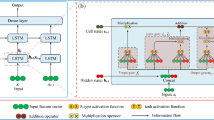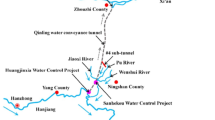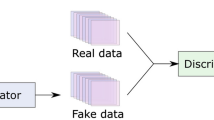Abstract
Accurate displacement prediction is critical for the early warning of landslides. The complexity of the coupling relationship between multiple influencing factors and displacement makes the accurate prediction of displacement difficult. Moreover, in engineering practice, insufficient monitoring data limit the performance of prediction models. To alleviate this problem, a displacement prediction method based on multisource domain transfer learning, which helps accurately predict data in the target domain through the knowledge of one or more source domains, is proposed. First, an optimized variational mode decomposition model based on the minimum sample entropy is used to decompose the cumulative displacement into the trend, periodic, and stochastic components. The trend component is predicted by an autoregressive model, and the periodic component is predicted by the long short-term memory. For the stochastic component, because it is affected by uncertainties, it is predicted by a combination of a Wasserstein generative adversarial network and multisource domain transfer learning for improved prediction accuracy. Considering a real mine slope as a case study, the proposed prediction method was validated. Therefore, this study provides new insights that can be applied to scenarios lacking sample data.
Similar content being viewed by others
References
Arjovsky, M., Chintala, S., and Bottou, L., 2017, Wasserstein generative adversarial networks: Proceedings of the 34nd International Conference on Machine Learning, 214–223.
Cao, W., Guo, X.B., Tian, F., et al., 2021, Seismic velocity inversion based on CNN-LSTM fusion deep neural network: Applied Geophysics, 18(4), 499–514.
Choi, B.S., 1997, A recursive algorithm for solving the spatial YuleWalker equations of causal spatial AR models: Statistics & Probability Letters, 33(3), 241–251.
Dragomiretskiy, K., Zosso, D., 2014, Variational Mode Decomposition: IEEE Transactions on Signal Processing, 62(3), 531–544.
Guo, Z.Z., Chen, L.X., Gui, L., Du, D., Yin, K.L., et al., 2020, Landslide displacement prediction based on variational mode decomposition and WA-GWO-BP model: Landslides, 17(3), 567–583.
Intrieri, E., Carla, T., Gigli, G., 2019, Forecasting the time of failure of landslides at slopescale: A literature review: Earth-Science Reviews, 193, 333–349.
Li, K., Lu, J., Zuo, H., et al., 2022, Multi-Source Contribution Learning for Domain Adaptation: IEEE Transactions on Neural Networks and Learning Systems, 33(10), 5293–5307.
Liu, Y., Feng, S., Qin, Z., 2019, Research on similarity evaluation method of landslide monitoring points based on motion-angle-difference: Rock and Soil Mechanics, 298 (01), 295–303.
Liu, Y., Xu, C., Huang, B., Ren, X.W., Liu, C.Q., Hu, B.D., et al., 2020, Landslide displacement prediction based on multi-source data fusion and sensitivity states: Engineering Geology, 271, 105608–105608.
Long, J., Li, C., Liu, Y., et al., 2022, A multi-feature fusion transfer learning method for displacement prediction of rainfall reservoir-induced landslide with step-like deformation characteristics: Engineering Geology, 297, 106494.
Xu, S.L., Niu, R.Q., 2018, Displacement prediction of Baijiabao landslide based on empirical mode decomposition and long short-term memory neural network in Three Gorges area, China: Computers and Geosciences, 111, 87–96.
Pan, S.J., Qiang, Y., 2010, A Survey on Transfer Learning: IEEE Transactions on Knowledge and Data Engineering, 22(10), 1345–1359.
Shi, Y.W., Deng, A.D., Ding, X., Zhang, S., Xu, S., et al., 2022, Multisource domain factorization network for cross-domain fault diagnosis of rotating machinery: An unsupervised multisource domain adaptation method: Mechanical Systems and Signal Processing, 164, 108219.
Wang, J., Zhang, J.H., Zhang, J.L., Lu, F.M., Meng, R.G., et al., 2021, Research on fault recognition method combining 3D Res-UNet and knowledge distillation: Applied Geophysics, 18(02), 199–212+274.
Yan, K., Wu, J.Y., Zhang, Y.Q., Yang, L., Zhang, Y.X., et al., 2019, Prediction Method of Deep Horizontal Displacement of Slope Soil Based on Damped Holt-Winters Model: Journal of Service Science and Management, 12(3), 391–406.
Yang, J., Yan, R., and Hauptmann, A.G., 2007, Cross-domain video concept detection using adaptive svms: In Proceedings of the 15th ACM international conference on Multimedia, 188–197.
Funding
This work was financed by the National Natural Science Foundation of China (Grant No. 51674169), Department of Education of Hebei Province of China (Grant No. ZD2019140), Natural Science Foundation of Hebei Province of China (Grant No. F2019210243), and S&T Program of Hebei (Grant No.22375413D).
Author information
Authors and Affiliations
Corresponding author
Additional information
Zheng Hai-Qing received her M. Eng. (2007) and Ph.D. (2010) in Control Theory and Control Engineering from Northeastern University. She is presently working in the College of Electrical and Electronics Engineering at Shijiazhuang Tiedao University. Her main research interests are landslide warning and signal processing.
Hu Lin-Ni is a graduate student in the College of Electrical and Electronics Engineering at Shijiazhuang Tiedao University. She is mainly engaged in slope stability analysis.
Sun Xiao-Yun, with a Ph.D. degree in engineering, is a professor and the dean of the College of Electrical and Electronics Engineering at Shijiazhuang Tiedao University. She was a visiting scholar at Michigan State University. Her research areas include computer control technology, electrical engineering, and nondestructive detection.
Zhang Yu is a graduate student in the College of Electrical and Electronics Engineering at Shijiazhuang Tiedao University. His research interest is information processing technology.
Jin Shen-Yi, Master of Science, Ph.D Candidates of Shijiazhuang Tiedao University. Her research areas include theory of rock and soil injury evolution and geological disaster prevention and control, Railway signaling and guided transport telematics.
This work was supported by the National Natural Science Foundation of China (Grant No. 51674169), Department of Education of Hebei Province of China (Grant No. ZD2019140), Natural Science Foundation of Hebei Province of China (Grant No. F2019210243), and S&T Program of Hebei (Grant No.22375413D)
Rights and permissions
About this article
Cite this article
Zheng, HQ., Hu, LN., Sun, XY. et al. Slope displacement prediction based on multisource domain transfer learning for insufficient sample data. Appl. Geophys. (2023). https://doi.org/10.1007/s11770-022-1003-x
Received:
Revised:
Published:
DOI: https://doi.org/10.1007/s11770-022-1003-x




